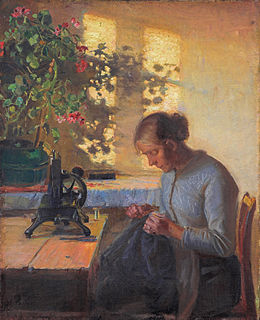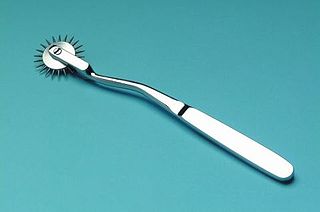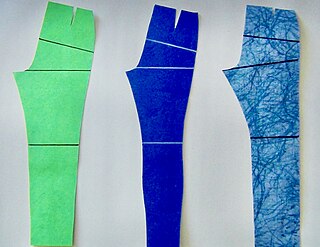
Quilting is the term given to the process of joining a minimum of three layers of fabric together either through stitching manually using a needle and thread, or mechanically with a sewing machine or specialised longarm quilting system. An array of stitches is passed through all layers of the fabric to create a three dimensional padded surface. The three layers are typically referred to as the top fabric or quilt top, batting or insulating material and the backing.

A dot matrix is a 2-dimensional patterned array, used to represent characters, symbols and images. Most types of modern technology use dot matrices for display of information, including mobile phones, televisions, and printers. The system is also used in textiles with sewing, knitting and weaving.

Sewing is the craft of fastening or attaching objects using stitches made with a sewing needle and thread. Sewing is one of the oldest of the textile arts, arising in the Paleolithic era. Before the invention of spinning yarn or weaving fabric, archaeologists believe Stone Age people across Europe and Asia sewed fur and leather clothing using bone, antler or ivory sewing-needles and "thread" made of various animal body parts including sinew, catgut, and veins.

Machine embroidery is an embroidery process whereby a sewing machine or embroidery machine is used to create patterns on textiles. It is used commercially in product branding, corporate advertising, and uniform adornment. It is also used in the fashion industry to decorate garments and apparel. Machine embroidery is used by hobbyists and crafters to decorate gifts, clothing, and home decor. Examples include designs on quilts, pillows, and wall hangings.

A Wartenberg wheel, also called a Wartenberg pinwheel or Wartenberg neurowheel, is a medical device for neurological use. The wheel was designed to test nerve reactions (sensitivity) as it rolled systematically across the skin. A Wartenberg wheel is generally made of stainless steel with a handle of approximately 18 centimetres (7 in) in length. The wheel, which has evenly spaced radiating sharp pins, rotates as it is rolled across the flesh. A disposable plastic version is available. Because of hygienic concerns, these devices are rarely used for medical purposes any more.
A zigzag is a pattern made up of small corners at variable angles, though constant within the zigzag, tracing a path between two parallel lines; it can be described as both jagged and fairly regular.

In sewing and fashion design, a pattern is the template from which the parts of a garment are traced onto woven or knitted fabrics before being cut out and assembled. Patterns are usually made of paper, and are sometimes made of sturdier materials like paperboard or cardboard if they need to be more robust to withstand repeated use. The process of making or cutting patterns is sometimes compounded to the one-word Patternmaking, but it can also be written pattern(-)making or pattern cutting.

In sewing, to tack or baste is to sew quick, temporary stitches that will later be removed. Tacking is used for a variety of reasons, such as holding a seam in place until it is sewn properly, or transferring pattern markings onto the garment. Tacking is typically sewn using a specialised tacking thread, which may snap easily in order for it to be easily removed from the garment when necessary.

Diver navigation, termed "underwater navigation" by scuba divers, is a set of techniques—including observing natural features, the use of a compass, and surface observations—that divers use to navigate underwater. Free-divers do not spend enough time underwater for navigation to be important, and surface supplied divers are limited in the distance they can travel by the length of their umbilicals and are usually directed from the surface control point. On those occasions when they need to navigate they can use the same methods used by scuba divers.

The straight or running stitch is the basic stitch in hand-sewing and embroidery, on which all other forms of sewing are based. The stitch is worked by passing the needle in and out of the fabric at a regular distance. All other stitches are created by varying the straight stitch in length, spacing, and direction.

Longarm quilting is the process by which a longarm sewing machine is used to sew together a quilt top, quilt batting and quilt backing into a finished quilt. The longarm sewing machine frame typically ranges from 10 feet to 14 feet in length. A complete longarming system typically consists of an industrial length sewing machine head a 10 to 14-foot frame, a table with a layer of plastic under which is placed a pantograph, and several rollers on which the fabric layers and batting are attached.
In patchwork, foundation piecing was originally a method used to stabilize pieces of fabric that were stitched together. It first became popular in the 18th and 19th centuries in England, although a 15th-century Italian piece, the Impruneta cushion owned by Antonio degli Agli, may have used foundation piecing. A similar process popular in Britain is English paper piecing.

Darts are folds sewn into fabric to take in ease and provide shape to a garment, especially for a woman's bust. They are used frequently in all sorts of clothing to tailor the garment to the wearer's shape, or to make an innovative shape in the garment. Fabric may be thought of as flat, and a dart has the effect of removing a wedge shaped piece and pulling the edges of that wedge together to create a shallow cone. This effect can be seen quite easily with a paper pattern by pulling together the edges of a dart intake as it would be sewn. Since fabric is generally more flexible than paper the fabric will shift around the apex of the cone and form a softer, but still curved, shape. In a garment a dart ends in a point at a full area of the body.
A patternmaker is a skilled worker who produces patterns on paper or fabric for use in the clothing industry.
Sewing is the craft of fastening or attaching objects using stitches made with needle and thread. Sewing is one of the oldest of the textile arts, arising in the Paleolithic Era. Although usually associated with clothing and household linens, sewing is used in a variety of crafts and industries, including shoemaking, upholstery, sailmaking, bookbinding and the manufacturing of some kinds of sporting goods. Sewing is the fundamental process underlying a variety of textile arts and crafts, including embroidery, tapestry, quilting, appliqué and patchwork.

In sewing, a seam is the join where two or more layers of fabric, leather, or other materials are held together with stitches. Prior to the invention of the sewing machine, all sewing was done by hand. Seams in modern mass-produced household textiles, sporting goods, and ready-to-wear clothing are sewn by computerized machines, while home shoemaking, dressmaking, quilting, crafts, haute couture and tailoring may use a combination of hand and machine sewing.
Pouncing is an art technique used for transferring an image from one surface to another using a fine powder called pounce. It is similar to tracing, and is useful for creating copies of a sketch outline to produce finished works.
A pattern notcher is a common tool used in patternmaking and sewing that creates a notch in a paper pattern. Notches are used to align pattern pieces. Notches in the paper are more useful than marks on the paper as they allow the mark to be seen whether pattern paper is face up or face down.
A sewing pattern is the template from which the parts of a garment are traced onto woven or knitted fabrics before being cut out and assembled. Patterns are usually made of paper, and are sometimes made of sturdier materials like paperboard or cardboard if they need to be more robust to withstand repeated use. Before the mid-19th century, many women sewed their own clothing by hand. Factory-produced fabrics were affordable and available in the early 19th century, but easy-to-use dress patterns and sewing machines for the home seamstress were not sold in the United States until the 1850s.

A coverstitch is formed by two or more needles which add straight stitches to the fabric and a looper thread on the opposite side of the fabric that zig-zags between the straight stitches. A coverstitch results in parallel lines of straight stitches on one side of the fabric and an overcast stitch on the reverse side. It is widely used in garment construction, particularly for attaching trims and flat seaming where the raw edges can be finished in the same operation as forming the seam.














